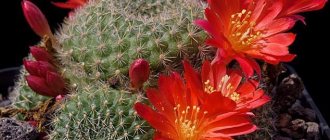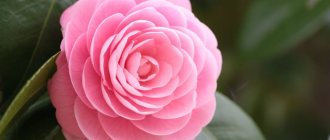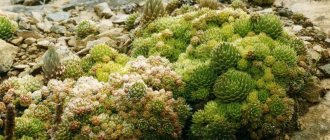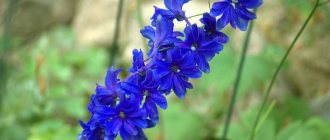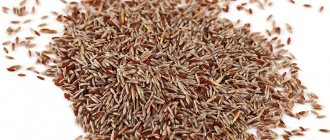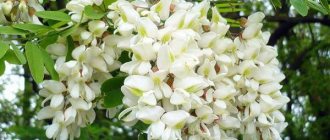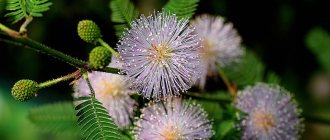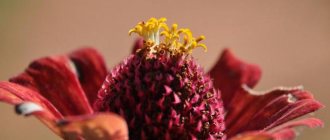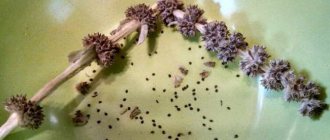Rhodiola rosea: varieties and varieties
Scientists have described about 60 species of Rhodiola rosea. The most popular varieties of radiola:
- Kirillova. Found in Tibet, Tien Shan, Altai, and North-West China. The height of the bush with a tuberous rhizome and dark green pointed leaves is from 30 to 40 cm. It blooms on the 10th of May and remains decorative for about a month.
Kirillova Rhodiola - Lineifolia. Homeland - mountains and forest meadows of Central Asia. It is a dioecious perennial plant with erect stems up to 0.3 m high.
Lineifolia rhodiola
- Varied-toothed. Prefers rocky soils of the Himalayas, Tien Shan, Tibet, Altai, Pamir. The leaves of the plant have a bluish tint and a triangular-ovate shape; the roots are almost on the surface.
Rhodiola heterodentata
- Golden root – a type of Rhodiola used medicinally. Habitat: Far East and Eastern Siberia, Altai and Arctic regions of Russia, Scandinavia.
Golden root
Description of the plant
Rhodiola rosea is an old synonym for sedum rosea . But no matter how Rhodiola rosea is officially called, its legendary old name still remains the most common. The popular nickname “golden root” was given to the plant for its special “metallic” bark on the roots. The plant received the name “pink root” not for its color, but for the rose-like aroma of its freshly broken rhizome. In addition, pink sedum is popularly known as Tibetan or Siberian ginseng.
Rhodiola rosea is a herbaceous succulent with powerful, thick roots - shortened, bearing dozens of renewal buds, from which succulent shoots develop. The roots are covered with a special, “mother-of-pearl”, bronze-golden bark. With the slightest damage or scraping, a bright lemon layer can be seen under the bark.
Similar to the “snakes” of other sedums due to their special foliage, the straight, non-branched, succulent shoots of Rhodiola create a very beautiful “bump.” With a height of 10 to 40 cm, one bush produces from 10 to 100 shoots. Along their entire length, they are decorated with sessile, alternately obovate, entire leaves, the size of which increasingly increases towards the top of the shoots, up to 3.5 cm.
At the tops of the shoots, small flowers of unexpectedly light yellow color are collected in small shields. This is a bisexual plant. After flowering, Rhodiola develops multileaf fruits with very small seeds.
At the tops of the shoots of Rhodiola rosea, small flowers of light yellow color are collected in small shields. © Tero Laakso
Planting Rhodiola rosea
Rhodiola loves light sandy soil, but if there is good drainage and appropriate care, it will grow in ordinary, non-waterlogged garden soil. To plant pink radiola, find a place that is well lit and protected from the winds. After July 20, dig the soil deep enough - 30 centimeters, remove weeds, level the surface. Next, apply fertilizer and dig again, then lightly compact the soil in the garden bed and mark the plantings using a cord.
You need to choose a place for Rhodiola that is sunny and protected from the wind.
If the soil is dense, then remove its top layer, removing 20 centimeters, cover the bed with river sand or brick chips, then return the removed soil. When the acidity is also increased, then bring this indicator to normal by adding dolomite flour or lime - on average 450 g per square meter. m.
Plants are planted at intervals of 0.5 m, leaving a distance of 0.7 m between lines. The roots are placed in the hole so that the renewal bud is flush with the ground. Immediately after planting, the bushes are watered and mulched the next day.
Care
Rhodiola rosea responds very well to organic fertilizers, and given that it grows in one place for at least three years, care should be taken to first apply humus or compost - 10-12 kg per 1 m2 or more. If there is little organic matter, then it is better to add it to the hole (0.5-1 kg). It’s a good idea to add 1 tbsp. a spoonful of superphosphate, potassium sulfate and ash. You should not get carried away with nitrogen fertilizers (except for diluted bird droppings 1:20). It is not recommended to allocate an area for Rhodiola after potatoes or cabbage.
Fertilizer and feeding of Rhodiola
For good growth of radiola in open ground, the bed allocated for growing radiola must be fertilized. For 1 sq. m add 2 buckets of manure (not fresh) or replace it with compost. Add to this:
- ammonium nitrate – 15 g;
- sylvinite or potassium salt - about 20 g;
- lime – 30 grams;
- granulated superphosphate – approximately 23 g.
It is advisable to feed the plant several times per season.
In the future, feeding will have a good effect on the growth and development of the perennial. Slurry is used for this purpose. First, it is allowed to replay for 5 days, then water is added in a ratio of 1:4 and the pre-moistened soil between the rows is watered abundantly.
Botanical characteristics of Rhodiola
Rhodiola rosea is a plant that has a strong root and grows for several years. The stems have cup-shaped leaves, and at their tops there are inflorescences of small yellow flowers. This plant is popularly called golden root. The fruits ripen in the last month of summer. The name comes from the specific shade that can be seen after breaking the rhizome.
Planting and harvesting
Most often, seeds are sown in the spring after they have been kept in damp sand for a month at above-zero temperatures. Planting is carried out in pre-prepared containers, which must be covered with film until good shoots appear. Afterwards the canopy is removed for good lighting and soil ventilation.
Seedlings are planted in the ground only at the beginning of summer; for full growth, a distance of 15 cm between plants must be maintained.
Caring for this plant does not require any additional knowledge or skills. In most cases, the first flowering is possible only in the third year of life. These plants reproduce by seeds or division of roots. As you can see, planting and caring for Rhodiola rosea does not require much time.
The roots are harvested as follows: at the end of summer they are dug up, thoroughly washed from the ground, and then cleaned of brown plugs and rotten roots. Before drying, the roots are cut into pieces up to 15 cm long. They are dried at a temperature of at least 60 degrees. It is recommended to store in a cloth bag for more than 3 years.
Medicinal qualities and contraindications of Rhodiola
Due to the content of a large number of useful substances, Rhodiola treats many different diseases. It is often used for the following diseases: diarrhea, scurvy, gout, diabetes, headaches, and menorrhagia. Tinctures are used for external treatment of abscesses, rashes and even conjunctivitis. Preparations based on this plant help with male and female diseases, as well as anemia.
Read also: Crocosmia planting and care in open ground in the Moscow region
The rhizome contains many tannins, organic acids, essential oils, sugar, proteins, fat, glycosides and manganese. Medicinal properties help calm, relieve fatigue and suppress depressive disorders. In addition, this plant strengthens the body's resistance.
Also, the use of Rhodiola entails the following results:
- stimulation of performance;
- improving heart function and normalizing blood pressure;
- helps eliminate bile and improves other body abilities;
- stops bleeding and restores overall strength after overwork;
- helps to tone and calm the body as a whole;
- leads to a decrease in body temperature and a decrease in allergic reactions;
- helps improve visual acuity and hearing;
- helps with tuberculosis and other types of cough;
- used as a common stimulant for the nervous system.
Like any other healing plant, Rhodiola has its contraindications for use: for individual intolerance, if the patient is under 12 years of age; with severe hypertensive crisis; during pregnancy and lactation; for nervous diseases with pronounced symptoms.
As can be seen from the above information, knowing all the medicinal properties and also contraindications of Rhodiola rosea, it is possible to use it without any problems.
Reproduction of Rhodiola rosea
It is not difficult to propagate this perennial. There are 2 ways to do this - divide the root and sow the seeds. If you want to get not only roots, but also seed material for the future, then it is better to propagate the golden root by sowing, then you will get male and female seedlings and collect seeds from the latter for the 2-3rd year. Sowing is done in late autumn or spring, in open ground or in boxes. Before winter, the bed is leveled, planting material is scattered over the surface, lightly rolled, and covered with agrofibre or film.
Rhodiola rosea sprouts
When sowing in a box filled with a light soil mixture, it is buried in the ground to the very edges and left there all winter. With the arrival of spring, the box is dug up and moved to a place well warmed by the sun, where it is buried again.
If you sow seeds in the spring, be sure to carry out stratification, for this:
- place the seeds in a growth stimulator solution for 24 hours;
- pour into wet sawdust, put in the refrigerator, where they will remain for a month or a month and a half at temperatures from 0 to 2 degrees;
- fill the box with soil mixture and scatter seeds mixed with sand over its surface.
Rhodiola rosea root
Golden root reproduces 2 times faster using its rhizomes. It is better to purchase perennial cuttings in the fall, and if you have your own bushes, dig up the root after the above-ground part dies. Divide so that each particle has at least 2 buds. Treat the cut areas with charcoal powder, let the cuttings lie until they wilt a little, and then plant them with a depth of maximum 1.5 cm.
Growing in the country
It turns out that you can start growing this amazing and necessary plant in your own garden. Despite the fact that its natural environment is remote, high corners, Rhodiola rosea will take root well in suburban areas. It is only necessary to create suitable conditions for her and provide minimal care.
Planting golden root
A well-lit, open place is suitable for this. The soil should be quite loose and fertile. You need to dig a series of pebbles into it, among which you plant the root, but you should not bury it deep into the ground - it should protrude above the soil level. It would be useful to add litter from the pine forest.
We must not forget that under ordinary conditions, that is, at a low altitude, Rhodiola rosea blooms in the spring, and then its shoots fade over time, and the plant loses its external attractiveness, even if it has previously received decent care. For this reason, it is necessary to think about how and with what to hide it. The golden root should not be planted in a conspicuous place, or it is necessary to place the plant nearby, which will subsequently cover it.
The most optimal place would be on an alpine hill, among stones and other similar plants.
Rhodiola requires virtually no care. But in the conditions where it grows, it often rains, and the plants themselves are almost constantly in water. For this reason, in the garden it is preferable to water it as often as possible, especially in summer.
How to breed?
This plant can be propagated at any time, but preferably after it has flowered. To do this, you will need to cut off part of the root with 2-3 buds, dry the cut a little, then plant it in another place.
Read also: Remontant raspberry orange miracle planting and care in open ground
It is possible to grow golden root from seeds, but there are certain difficulties. Rhodiola rosea seeds must certainly undergo stratification, for which they should be sown in a box in the fall, sprinkled with a little sand and buried in your area, covered with film on top. In addition, stratification is carried out using a refrigerator. To do this, you will need to sow the plant in a small bowl or wrap it in a damp cloth. It takes about one and a half months to keep the seeds in the cold.
Seeds prepared in this way are then germinated in a room where the temperature does not exceed 19 degrees. It is preferable to continue to keep the emerging seedlings in the box, since they grow for a long time, especially slowly in the 1st year. And after 1-2 years, the golden root can be planted on the site.
Plant care
The emerged seedlings of Radiola rosea gain strength so slowly that transplanting them to a permanent bed is possible only after a year. While they are growing, you should carefully weed the plantings and loosen the soil between the rows. When the leaves grow up to 5 cm in length, they are fed. During drought, bushes need watering. In order for the plants to successfully overwinter, in late autumn the soil around them is mulched using humus or peat.
The plant requires constant attention: weeding, watering, pruning and protection from winter cold.
Next year, the roots will grow to such an extent that they begin to peek out of the ground, and then caring for each bush consists of hilling.
Attention! The healing power of plants obtained from seeds will appear after 5 or even 6 years, and if you propagated radioluna by dividing rhizomes, you will be able to dig them up after 3 years.
Propagation by seeds
It is necessary to pay attention to one feature. Rhodiola rosea seeds are very similar to sedum seeds
. But these two plants can be distinguished literally a week after germination. Rhodiola cotyledons have elongated “legs” (petioles) and at a week of age they are arranged in the form of the Latin letter V, and in the cotyledons the sedum petioles are not visible. They sit side by side, and real leaves literally grow “out of the trunk.” If you are observant, you can avoid misunderstandings and not spend years growing sedum.
The most accessible method of propagating Rhodiola rosea is by seed. Seeds are sown in late autumn or winter in a small box filled with light, nutritious, breathable soil. A 5 cm layer of expanded clay is poured onto the bottom of the box. The soil is spilled with a weak solution of potassium permanganate and lightly compacted. After this, scatter the seeds evenly over the surface and lightly press them with your palm. A layer of sand (about 2 mm) crumbles on top. The box is covered with film and placed on the balcony or in the garden. If there is already snow, you can cover the crops with snow and cover them again with film, which protects the seeds from being washed away during thaws and from birds.
In mid-March, the box is installed in a warm, bright place
. After a few days, when friendly shoots appear, the film must be removed. Watering should be done very carefully.
The first days the plant develops very slowly. It may turn out that in one part of the box the seeds have sprouted densely, while in the other there are clearings. Therefore, at a week old you can start planting plants. But this must be done very carefully, although everything is quite simple. Both the intended planting site and the plants themselves are well watered. The main “tool” for transplanting is a match. A “hole” is made with a match, then a plant with a lump of earth is picked up with the same match and transferred to the hole.
You can use another method of growing Rhodiola, which also pays off, and in this case the seedlings are even stronger and more developed. Rhodiola is sown in standard flowerpots that hang on the balcony. In winter, the flowerpot is tied with film, and with the onset of spring, a canopy made of a wire frame covered with film is fixed above it on the railing. In the spring, the shoots appear friendly and in their development surpass even those that were in the apartment.
After 1.5-2 months, the seedlings are transplanted to a permanent place in the garden. This can be done at any time, but only carefully, with watering, and if it’s hot, then shade it. Even in the first year, some plants bloom, although they do not produce seeds.
And one more piece of advice for beginners: don’t strive to have many Rhodiola plants of the same age. Due to the fact that the golden root rhizome reaches maturity by 4-5 years
, it is better to have plants of different ages, planting new ones every year.
Diseases and pests of golden root
Rhodiola rosea rarely gets sick, and pests are not scary for it, although sometimes it is attacked by bergenia or sedum weevils. The first one can enter the site along with the rhizome, which previously grew under natural conditions. This insect damages the most valuable part of the plant - the roots. So when purchasing the starting material, inspect everything carefully, and if you find larvae already at home, then place the root in a saline solution for 10 minutes. or in potassium permanganate for 15 minutes.
Weevil beetle
The second pest causes damage to the above-ground parts. Its presence is indicated by small holes on the leaves, then the leaf turns yellow. The stem is also damaged by the larvae - the pests make tunnels in it. To get rid of sedum weevil, shake it off onto a material coated with some kind of adhesive. Do this both in spring and autumn.
Features and morphological description of Rhodiola
The Rhodiola plant is a mountain herbaceous perennial that belongs to the Crassulaceae family. She is a representative of succulents. The place where Rhodiola grows is most often mountainous or rocky. Today the culture can be found in hard-to-reach mountain regions of Scandinavia, Altai, Pamir, Tien Shan, the Balkans, Carpathians, Transbaikalia, North America and Great Britain, on the coast of the Barents and White Seas, the Urals and Siberia. As you can see, this succulent has become extremely widespread, but today this amazing plant is listed in the Red Book as an endangered species.
Rhodiola simply has a huge, centuries-old history, which consists of various legends and traditions regarding its origin. The perennial plant was first described in the 1st century AD. physician Dioscorides. For a long time, Rhodiola or golden root was considered a healing plant that helped prolong life. Chinese emperors, Altai hunters, Vikings and shepherds drank tinctures and teas made from succulents. The plant was especially popular in Altai, the fame of which spread far throughout the world. It was to Altai that people began to come in search of the golden root. The secret of this plant was known only to the indigenous people, who did not reveal the secret of its spring appearance to anyone. That is why for many years expeditions of scientists could not find the famous golden root, while knowing very well the plant called Rhodiola rosea.
And only in 1961, one of their expeditions established that the legendary golden root and Rhodiola rosea are the same plant. After this discovery, tourists began to appear in Altai, plucking and digging up the healing roots of Rhodiola, which led to the extermination of the plant and its inclusion in the protected list.
Rhodiola or Rhodiola received its scientific name in 1755, which was given to it by the famous scientist Carl Linnaeus. The origin of the definition is Greek from the words “rhodon” or “rhodia” or Latin from the word “roseus” - translated as “pink”, “rose”. This is due to the fact that when the root of Rhodiola is broken, a pleasant smell appears that is reminiscent of the aroma of a rose flower. You can often hear the names golden root or pink root. This plant is called golden root because of the pearlescent hue of the root, while others claim that when cut, the roots become pinkish - hence the pink root.
Description of Rhodiola:
- Rhodiola is a perennial herbaceous plant that belongs to the Crassulaceae family, although for some time this representative of succulents was classified as a completely different species and genus. Previously, all Rhodiola varieties were classified in the genus Sedum or Sedum.
- This plant has a very thick and fleshy tuberous rhizome, which very much in appearance resembles a human hand with five fingers. The rhizome itself is located almost on the surface of the soil, and the thin roots of Rhodiola go deep.
- The rhizome has a brownish-brown tint with pearlescent scales. It is from this color of the root that the popular name of the plant comes from - golden root. Another feature of the tuberous rhizome of Rhodiola is the large number of renewal buds, which contributes to the growth of the perennial.
- Erect or slightly curved, non-branched stems emerge from renewal buds. There can be several of them on one plant, it all depends on the specific variety of Rhodiola. On average, there are 10-15 stems in an adult bush and 1-2 in a young plant.
- The stems are very thick and fleshy, which indicates that this plant belongs to succulents, which thus accumulate water.
- All shoots can reach a height of 10-60 cm, it all depends on the type and variety of Rhodiola.
- The leaves are sessile, alternate, very thick and fleshy, located on the stems in peculiar tiers almost at right angles.
- On the superficial rhizome or caudex, the leaves are scale-like; on the stems they have an oblong ovoid or triangular shape. The leaf blade is pointed at the end and jagged along the edge, has a light green color with a bluish tint.
- Rhodiola flowers are unisexual; one bush can have only male or only female flowers. At the same time, you can quite easily determine whether flowers belong to a certain gender: male flowers are brighter and larger, while female flowers can remain green even during flowering.
- The flowers of this plant can have different structures: they can be five-membered or six-membered.
- Small yellow flowers are collected in corymbose or paniculate inflorescences at the tops of the stems.
- Rhodiola blooms around the end of May or early June.
- After the flowers fade, fruit appears on the tops in the form of red or green leaflets. The length of one leaflet can be 6-8 mm.
- At the end of June or at the beginning of July, Rhodiola seeds ripen, which are very small in size.
- This representative of succulents is often used for decorative decoration of the site and for medicinal purposes, due to its beneficial properties and the content of a large number of useful vitamins and substances.
Rhodiola rosea in landscape design
Radiola rosea is valuable not only as a medicinal plant, its decorative appearance allows the bushes to be used to decorate the site. In landscape design, it is used in the design of rockeries, alpine slides, and flower beds. When planting this perennial, you should remember that already in August the above-ground part will begin to die off, so next to it there should be plants that retain greenery until frost in order to mask the resulting void.
Rhodiola looks great on alpine slides
Application in cosmetology and folk medicine
We have all heard about the medicinal properties of Rhodiola rosea. But not everyone knows about the correct and safe use of golden root. You can buy Rhodiola rosea at any pharmacy or prepare the mixture yourself. From it you can make a medicinal decoction, infusion, oil and even cream (Figure 5).
Note: We suggest that you familiarize yourself with the basic recipes for this plant. Based on golden root, an excellent remedy for male potency is obtained. It is very practical and affordable to prepare at home.
To prepare the decoction you need only 30 grams. dry golden root and 300 ml of water. Grind the root very finely and add water, then cook until boiling in a water bath. After half the liquid has evaporated, set the container with the contents aside. Then strain by squeezing through cheesecloth. You need to take 2 times a day, 1 tbsp. for one month.
Figure 5. In folk medicine, the roots and aerial parts of the plant are used
You can also prepare a tincture to increase libido in women. Prepare 100 grams of Rhodiola rosea root, 500 ml of alcohol and 150 ml of water. Grind the roots, add water, then bring to a boil. After the drink has cooled to room temperature, pour the entire contents (with roots) into a glass container and add alcohol. Next, closing the jar tightly, place it in a dark and preferably cool place. After 2 weeks, the finished tincture must be strained from the root. Take 15 drops 2 times a day for two weeks.
In addition, similar infusions can be used to wipe damaged skin and make various infusions and lotions. However, before starting such treatment, it is important to consult a doctor, since traditional medicine often causes allergies.
But in cosmetology, Rhodiola rosea is used quite actively, because it has pronounced nutritional properties and the ability to smooth out wrinkles. For example, you can make medicinal cosmetic oil from it. To do this, take 10 grams of plant root and 100 grams of olive oil. The roots are crushed to a powder and poured into oil heated to a temperature of 37 degrees. Next, all the ingredients need to be thoroughly mixed to form a thick viscous mass.
Figure 6. This unusual culture is actively used in landscape design
The finished product is rubbed into the skin of the face and neck with circular massage movements, and after 15 minutes, washed off with warm water. After just a few uses, the skin becomes more toned, and the formation of wrinkles slows down significantly.
Rhodiola rosea: combination with other plants
Attention!
In landscape design, golden root is combined with crops that, like it, do not experience an increased need for abundant watering, otherwise the roots will begin to rot. When using radiola rosea as a medicinal plant, it is combined with raspberry, strawberry, currant, blackberry leaves, as well as with such medicinal herbs as thyme, bloodroot, and St. John's wort.
By growing radiola rosea, you will preserve this rare plant for posterity, provide yourself with valuable medicinal raw materials, and the landscape design of your site will only benefit from this.
How to harvest Rhodiola rosea and where it can be used
Harvesting this plant should be done only after the golden root has flowered, in the summer. It is dug up, thoroughly washed with water and dried a little with a clean cloth. Then you need to cut the root into small pieces and lay it out to dry in a shaded area. Can be dried in a special drying device.
After drying, the root in the cut area becomes pink and emits a unique smell.
The most basic method of use is to make an alcohol or vodka tincture from it, which requires crushing Rhodiola rosea and pouring 1 to 10 alcohol into it. It takes about two weeks to infuse. You need to drink the resulting tincture ten drops twice a day before meals.
So, caring for golden root will not require any special skills from you and will not force you to spend a lot of time growing it. Planting a plant growing in mountainous areas is possible even in summer cottages in central Russia. Without much hassle, you can obtain valuable raw materials that are successfully used in both folk and traditional medicine.
Rhodiola rosea: photo
Agricultural technology for growing Rhodiola: secrets and nuances of care
Caring for Rhodiola is quite simple, provided you choose the optimal place for planting the plant and carry out the planting process correctly.
- Watering. Rhodiola is considered a moisture-loving plant that stores water in its thick leaves and stems, but cannot do without watering for a long time. This plant prefers flow-through watering, when it is watered not from above, but at the root. It is necessary to water the plants when the top layer of soil dries out.
- Loosening and mulching. It is recommended to regularly loosen the surface around the plants to ensure oxygen access to the roots. You need to loosen it very carefully, since the root system is located almost on the very surface. The soil can be mulched with fallen leaves or grass to prevent the roots from overheating. Also, over time, the Rhodiola rhizome protrudes greatly, so it must be sprinkled with nutritious soil or hilled up.
- Feeding. Rhodiola is in dire need of regular feeding. It is usually recommended to carry out 2 feedings, the first of which occurs during the active growing season. Most often, slurry is used to fertilize plants. To do this, fresh manure is infused for 5 days, after which it is diluted in water in a ratio of 1 to 4.
- Pests and diseases of Rhodiola. This plant is very rarely affected by various diseases and is subject to pest invasion. Sometimes bushes can get powdery mildew or blackleg. In this case, it is necessary to use special chemicals. However, remember that the plant cannot be used for medicinal purposes after treatment for at least 6 months. Among the pests you can sometimes find the weevil. It is not recommended to use chemicals; you can simply shake the insects onto a sticky surface and destroy them.
- Shelter for the winter. To prevent Rhodiola from freezing in winter, in late autumn it is recommended to mound the root of the plant high and mulch the top with peat or humus.
Choosing a place and landing
Rhodiola rosea is a very moisture-loving plant; at the same time, it loves loose, light soil, which drains moisture well and allows the roots to breathe. It is best to grow it on light loam, but even if the soil in your garden is dense and clayey, there is a way out. The plant will develop quite normally on it, but provided that you are not too lazy to create artificial drainage by placing expanded clay, pebbles or middle fraction screenings under the root. Such care will not allow moisture to stagnate and will protect the tuber from rotting.
The drainage is laid at a depth of about 30 centimeters, having first removed the top layer of soil, after which it is laid in place. It is advisable to determine the acidic properties of the soil, since the plant loves neutral or low-acid compositions. You can check this indicator with a litmus tester and, if necessary, reduce the acidity by adding lime or dolomite powder, but not more than 400 grams per square meter.
Rhodiola rosea loves good light, slightly diffused, so you should not plant it in the shade. When choosing a location, it is also worth considering protecting the plant from winds, and especially from drafts - Rhodiola does not like them.
The plant is under threat of destruction
Planting should be carried out in mid-summer, having first loosened the prepared area to a depth of at least a quarter of a meter, then feed the soil and mix the soil again. In this case, you need to be careful and, if a drainage layer is laid, the depth of loosening should be less than the depth of its occurrence.
After these procedures, you can mark the beds and plant plants. Tubers are planted in rows, with an interval of about 60 centimeters, and the distance between bushes in the rows should not exceed half a meter.
Proper root penetration is of particular importance. It is necessary to ensure that its growth point is not underground, but also does not protrude much above its level - this is a prerequisite for successful root growth. The planted bush must be watered immediately and as soon as the earth is shaken, mulch it, but only so that the growing point remains on the surface - it breathes freely.
Preparation of medicinal raw materials
The optimal time to start harvesting roots is August-September, when the female plants are in the fruiting phase (when harvesting raw materials in natural conditions, this is very important, because seed shedding occurs, which ensures the subsequent resumption of natural thickets). Dig out large plants with roots with a shovel. The rhizomes are shaken off the ground, washed in running water, and cleaned of old brown plugs and rotten parts.
Dry in the shade, cut lengthwise and dry in a dryer or oven with the door ajar at a temperature of 50-60 °C. It cannot be dried in the sun. The color of the dried roots is golden, and in the cut areas it is white, pinkish or light brown, but not brown. The smell is specific, somewhat reminiscent of a rose. Store dried roots in linen bags or paper bags in a dry, well-ventilated area. Shelf life 3 years.
When procuring raw materials in natural thickets, do not dig up the rhizomes completely, leave part of the roots in the ground.
Rhodiola rosea. © Opiola Jerzy
The use of Rhodiola in decorative floriculture
Although rhodiola is mostly associated with the pharmacy, many gardeners grow it as an ornamental plant. On the site, it looks good on a rocky hill, among stones in a rock garden; its golden inflorescences go well with blue muscari. The decorative advantages of the plant include early regrowth, immediately after the snow melts, in June it already blooms, the seeds ripen in August-September. With good watering, the bushes remain green until autumn. If moisture is insufficient, then after fruiting the above-ground part of the plant dies.
Recently, due to the passion for Rhodiola, many amateur gardeners obtain planting material from markets and from friends. And instead of Rhodiola, they often come across other plants of the same family. It would be good if it turns out to be another type of Rhodiola, but much more often you come across two types of sedum instead. Surviving sedum (sedum) is especially often grown, and hybrid sedum is less common. Sedums have flowers with 5 petals, which distinguishes them well from Rhodiola, which has 4 petals. But usually seedlings are bought in spring or autumn, when there are no flowers. How to distinguish these plants?
Pay attention to the roots. Both types of sedum have a powerful root, shaped like a carrot, often forked and branched, with conical roots pointing downward. Even in a very small, one-year-old sedum plant, this “carrot” is clearly visible. The color of the rhizome is light, the cork is matte without shine, often with darker specks. In Rhodiola, the bulk of the rhizome is located horizontally and the roots extend from this rhizome. A one-year-old seedling has an almost spherical “tuber” at the bottom, the size of a small pea. Older rhizomes develop a characteristic “golden” shine, especially noticeable on a damp surface.
Medical properties
Despite its invisibility (it grows in inaccessible places), golden root has long been known to residents of mountainous regions. Tibetan and Altai healers knew its healing properties and used it, first of all, as an anti-fatigue remedy that increases activity.
At the moment, the plant has been studied by doctors and is used not only in folk, but also in classical medicine.
In folk medicine, golden root is much more often used as a means of increasing productivity.
There is no need to drink preparations from this plant in the evening and take excessive doses - an overdose can cause insomnia and excessive irascibility.

